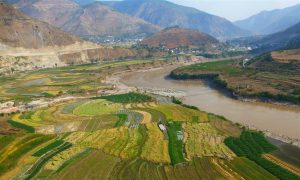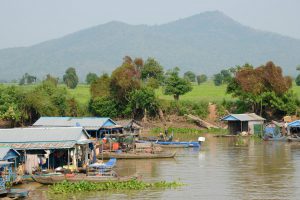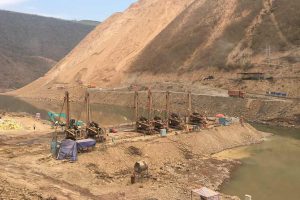It is now two and a half years since the first Lancang Mekong Cooperation (LMC) leaders’ summit was held in Sanya city on Hainan Island, China. The aim of the LMC – a China led multilateral body involving all six Mekong countries – is to deepen economic, cultural and political ties between China and mainland Southeast Asia. Leaders have repeatedly declared the importance of the Lancang-Mekong River to this cooperation. Reflecting this, the LMC hosted the “1st Lancang-Mekong Water Resources Cooperation Forum” in Kunming, China at the start of November.
The LMC’s second leaders’ summit in Phnom Penh, Cambodia in January 2018 revealed the swift pace of the initiative. This is reflected in the numerous senior-level meetings between governments, the initiation of almost 200 China-funded projects, and the LMC’s deepening institutionalisation through various LMC secretariats and working groups. Yet, while China has hosted people-to-people exchange programmes and university scholarships, the LMC’s state-centric approach has afforded little opportunity for public deliberation about its overall policy principles and direction.
 Mekong Lancang leaders sign deals at the second summit in Phnom Phen (Image: KT/Chor Sokunthea)
Mekong Lancang leaders sign deals at the second summit in Phnom Phen (Image: KT/Chor Sokunthea)
Through the LMC, some government officials and scholars from China have proposed that downstream and upstream countries have both rights and responsibilities towards each other. This concept of "reciprocity" is not yet official LMC policy, but suggests a shift in government position compared to China’s earlier unilateral construction of dams on the Lancang River. Overall, the LMC and its proposition of reciprocity appears to be an invitation to negotiate basin-wide water cooperation on the Lancang-Mekong River.
However, much remains uncertain. For example, how will the LMC build upon the existing inter-governmental Mekong River Commission, established in 1995 by the four lower basin countries? How will the LMC address concerns of riverside communities and civil society and ensure their meaningful inclusion? And how will countries ensure the river’s ecological health given the strong push for economic growth and associated water infrastructure projects? This article asks whether the LMC and the concept of reciprocity is a promising approach to meet these challenges.
Hydropower and diplomacy
Since the early 1990s, the Lancang-Mekong River has been transformed from a free-flowing river to one that is increasingly engineered by large hydropower dams. In the lower Mekong basin, almost sixty medium or large hydropower dams are in operation, with over twenty more under construction. Meanwhile, upstream China has unilaterally built six large hydropower dams on the main stream in Yunnan province. This hydropower construction has taken place in a context of deepening regional economic integration, where electricity is traded across regions, for example from Yunnan province to south-east China, and across borders, from Laos to Thailand and Vietnam.
As of 2008 dams on the river had the capacity to store less than 2% of the total flow in the Lancang Mekong basin, but this could increase to 20% by 2030. According to China’s Ministry of Water Resources, reservoir operation reduces flood season flow by around 30% and increases dry season flow by around 70%.
 The Nam Kong 1 dam, one of the many under construction in the Mekong (Image: Luc Forsyth)
The Nam Kong 1 dam, one of the many under construction in the Mekong (Image: Luc Forsyth)
This dam construction has produced both benefits and harms, depending upon the perspective of the river user. Claimed benefits include more water available for irrigation, navigation and hydropower production in the dry season, alleviation of extreme drought and floods, and economic benefits from intensified use of the river’s resources. Yet, some of the many negative impacts have been on wild fisheries, local river ecologies, and sediment transportation, with dams holding back nutrient rich silt affecting river bank erosion and delta formation. While project developers and governments increasingly tout benefit-sharing mechanisms, the overwhelming risks are borne by the poorest communities who depend upon the river’s resources for their livelihoods.
 Traditional fishing in the Mekong delta (Image: Uwe R Zimmer)
Traditional fishing in the Mekong delta (Image: Uwe R Zimmer)
In March 2016, as the region faced a severe drought, China released water from its Lancang dams, one week before the first LMC summit. China’s Ministry of Foreign Affairs spokesperson argued this showed China’s "water facilities" helped control floods and address droughts. However, local media reported that some communities in Thailand were not informed in advance of the water releases and suffered deleterious impacts. This shows greater coordination is required across the transnational to the local level. It also brushes over the history of the upstream dam projects and the harm created through their construction and operation.
Momentum builds on the LMC
The LMC has built up its institutional structures significantly, establishing annual foreign ministers’ meetings, and numerous senior government meetings and trainings. a secretariat and a Lancang-Mekong Water Resources Cooperation Center, based in Beijing, and a Global Center for Mekong Studies linking think tanks across the region.
China considers the LMC to be a component of the broader Belt and Road Initiative, to develop infrastructure and regional connectivity across strategic land and maritime routes. The LMC is also held up as an example of “South-South cooperation”, and claims to be working towards the UN 2030 Agenda for Sustainable Development. Further deepening economic ties is a core focus. China is already a major trade partner, and major investor, in all of the countries in mainland Southeast Asia ranking as first or second important in most cases. Under the LMC, China plans numerous regional integration projects, including infrastructure such as roads, railways, power grids, telecommunications and river rapids blasting.
To further the water agenda, the LMC established the Lancang Mekong Water Resources Cooperation Center (LMWRCC) with its secretariat in Beijing. The LMWRCC aims to become a platform for cooperation in technical exchanges, capacity building, drought and flood management, data and information sharing, and conducting joint research. However, there is little information in the public domain about its work. Activities to date have focused on meetings amongst government officials and experts, with only limited opportunity for civil society and community to share their own knowledge.
What of the Mekong River Commission?
A key question is how the LMC will work with the existing river basin organisation. In 1995, the governments of Cambodia, Laos, Thailand and Vietnam jointly established the Mekong River Commission (MRC) through an international treaty, namely the Mekong Agreement. This aimed to strengthen transboundary water governance, but in practice the MRC has struggled to influence government decision-making. After Laos moved ahead with construction of the Xayaburi and Don Sahong dam on the Mekong before the MRC could conclude its regional consultation, the Save the Mekong civil society network boycotted the MRC’s most recent consultation on the proposed Pak Lay dam.
China has not been willing join the MRC, preferring to remain a “dialogue partner”. German academic Sebastian Biba argues that China’s coordination has been sporadic and often only to avert worsening tensions, for example during a flood in 2008 and a drought in 2010. China, meanwhile, has considered the MRC to be overly influenced by countries outside the region through its funding and research, and potentially yielding too much influence to the downstream countries over its dam construction plans.
The momentum building around the LMC threatens to eclipse the MRC, which has sought to establish its own legitimacy, while emphasising its cooperation with the LMC and China more broadly.
The MRC argues it is the only organisation mandated by international treaty and to undertake lower basin-wide planning. It holds annual ministerial-level meetings, engages with civil society and has built an extensive knowledge base, including a strategic environmental assessment of Mekong mainstream dams.
The MRC claims that cooperation with the LMC is increasing. Examples include wet-season data sharing and occasional dry season sharing, staff exchanges and field visits, collaboration around the MRC summits and some joint research.

Chinese flagged river boats tied up in the port in Chiang Saen, Thailand. (Image: Jack Kurtz)
Yet, it seems inevitable that a joint organisation will emerge in the future, although the form that it might take, and the principles and rules that would guide transboundary water cooperation, remain important open questions.
Reciprocity as a principle of Lancang-Mekong cooperation?
The UN Watercourses Convention (UNWC), adopted in 1997, came into force in August 2014. It is a global treaty for governing international watercourses. Key principles include "equitable and reasonable utilization," the obligation "not to cause significant harm," to exchange data, and to cooperate.
China, along with Burundi and Turkey, voted against the convention. As the upstream country on most of Asia’s major rivers, China argues that the convention privileges the interests of downstream countries and would not be in their national interest.
As Zhong Yong of Tsinghua University, and now Secretary General of the LMWRCC, wrote in a 2016 academic paper, the UNWC does not sufficiently consider how downstream development of water resources, such as irrigation and hydropower, could harm upstream states if countries used this to claim priority rights to the river. The authors argue that the UNWC is often misunderstood by downstream states, which do not recognise that they also have responsibilities towards upstream states. The authors propose the principle of reciprocity should be integral to the UNWC, where downstream states should acknowledge the rights of upstream states to develop their resources (and vice versa). This, they say, could encourage upstream states to engage with the UNWC.
The concept of reciprocity has gained some policy traction among official circles in China. Meanwhile, academics at several universities in China, including at Xiamen and Chongqing, are re-evaluating the idea of reciprocity for the international norms of the UNWC to better reflect China’s interests. This could encourage China to engage with the treaty in the future.
Towards inclusive reciprocity
Over 70 million people live within the Lancang-Mekong River basin that traverses six countries from headwater to delta. Given that they hold diverse relationships to the river and hold competing claims over its use, cooperation between countries that share the river is essential to ensure inclusive, fair and sustainable outcomes. Could reciprocity be an entry-point to serious negotiations on a rules-based regime for the entire Lancang-Mekong basin?
First, for reciprocity to gain policy traction under the LMC, it must be relevant to the Mekong region. To date, there is little evidence that downstream governments have sought to limit China’s upstream development, even when pressured by civil society to do so. Meanwhile, there is also little evidence that a consideration of reciprocity has tempered China’s upstream behaviour to date, including its unilateral dam construction without prior notification of consultation with downstream countries. How to evaluate and redress for past harm caused by dam building will be important for the legitimacy of the concept moving forward and to revive the possibility of a UNWC-based Lancang-Mekong agreement.
Second, the LMC has emphasised the role of government officials and experts, rather than involving wider civil society. Its emphasis on economic growth and associated infrastructure, including large hydropower dams and rapids blasting, however, is a threat to the ecological sustainability of the river, and to those who depend directly on its resources. Both researchers and practitioners widely recognise that multi-level institutions from the transnational to the local involving state, civil society, business and community members are needed for effective governance of the water commons. In other words, there is a need to move towards “inclusive reciprocity.” Until the LMC can accommodate genuine participatory processes itself, however, civil society groups and researchers need to organise alternative workshops and forums that include perspectives from the wider public and encourage debate.
Third, there is much that can be done regarding sharing and creating knowledge. At the level of inter-governmental and expert cooperation, there could be increased data sharing on the river, starting with, for example, dry season flow data. There could also be in-depth discussion on the state of knowledge, including the resources of the MRC and academic and government institutions across the region. The LMC has already initiated some limited collaborative expert-led studies to date, and this could be expanded, especially to evaluate impacts of existing water infrastructure projects before further ones are proposed.
Furthermore a wide-range of research institutions should be involved in research on reciprocity and international water law, funded from diverse sources, to ensure a constructive and rigorous debate. It is also important to acknowledge the knowledge of river-side communities and various civil society research initiatives. Only through sharing and deliberating these multiple forms of knowledge can a more complete picture of the Lancang-Mekong River and its diverse economic, social and cultural value be attained.
Fourth, the concept of reciprocity should be extended to acknowledge the fundamentally reciprocal relationship between society and nature. To date, under the LMC, reciprocity has only referred to the relationship between states, where the river is viewed as an economic resource that at best should be sustained for the instrumental reason of continued provision of economic benefits. There is a growing movement globally to acknowledge the intrinsic value of nature, and the duty to protect it, that also resonates with many people’s opinion in Southeast Asia. Thus “ecological reciprocity” should maintain a healthy river ecosystem and a balance between the interests of both humans and non-humans.
Acknowledgement
This opinion piece is written based on ongoing research with support from the Competing Regional Integrations in Southeast Asia interdisciplinary research programme funded by the European Union’s Horizon 2020 Framework Programme. This article is a summary of a CSDS policy brief published in November 2018.
This article is republished from The Third Pole








